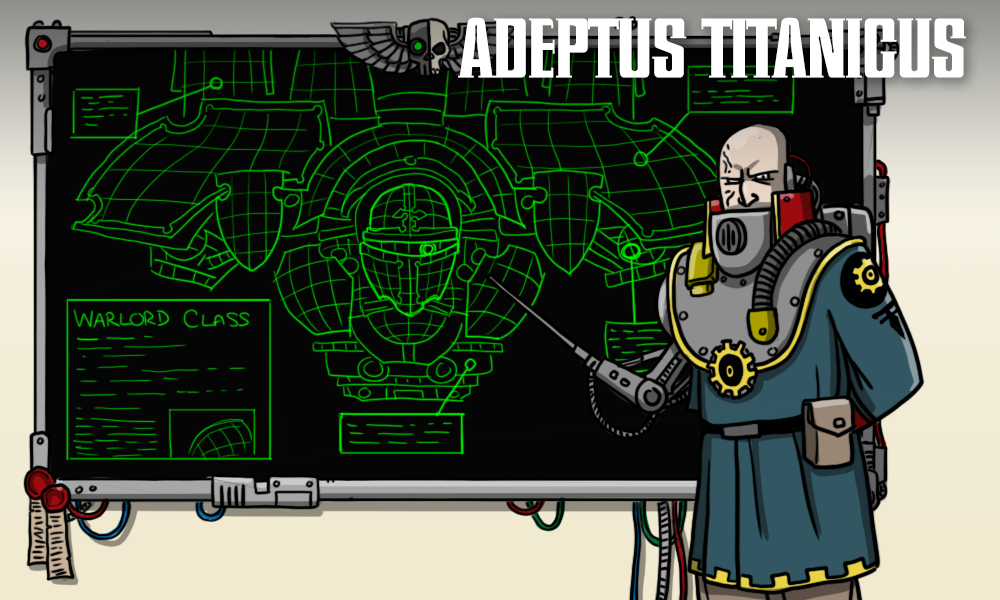Welcome back to Goonhammer’s series for aspiring Titan Principes. We here at Goonhammer’s own Collegia Titanica know that Adeptus Titanicus can seem intimidating to players unfamiliar with its particular quirks, but this series aims to equip you with everything you’ll need to play out epic clashes on the battlefields of the far future with your very own Titan Battlegroup. In this series, we’ll be taking a more in-depth look at the various Legios of the Collegia Titanica – exploring their origins and how to use them on the tabletop, from maniple selection and their loadouts, through to how to command them on the field of battle to secure ultimate victory.
One of our favourite Loyalist Legions got hit with the nerf bat last week, so now’s as good a time as any to revisit Legio Fortius. Despite the changes to their trait, the Dauntless have some of the most options of any legion available to them while assembling their battlegroups. Read on to find out how you can leverage this flexibility to find a way to victory in your own games.
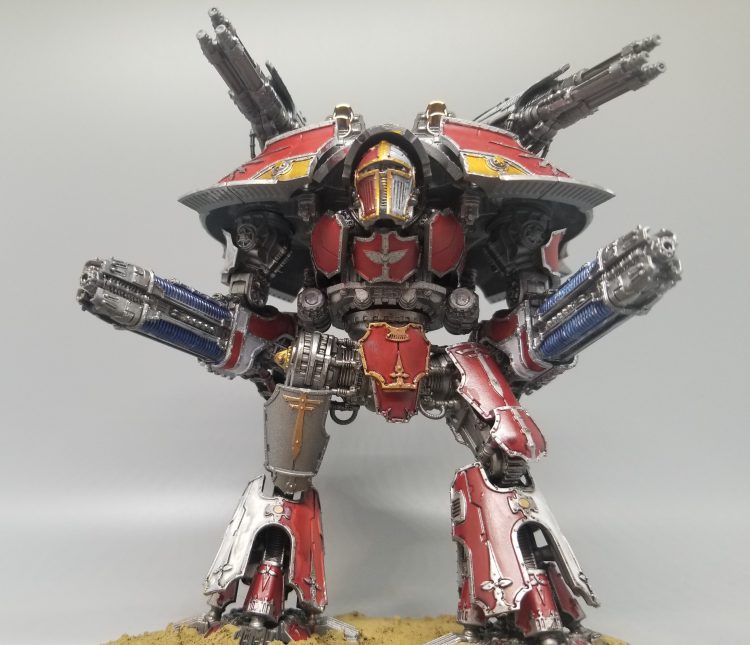
Who are Legio Fortidus?
Legio Fortidus were an ancient Titan Legion based on Holy Mars. The Legion was nearly destroyed as the Horus Heresy began, losing their Martian forces during the Death of Innocence, the opening salvo of the Schism of Mars, where virulent scrapcode was released, sending their Titan reactors critical.
Refusing to go down without a fight, off-world elements of the Legion stoically carried on, making Traitors paying a high toll for any ground given, such as on Molech where their sacrifice allowed time for many civilians to flee their imminent doom.
Painting Legio Fortidus
We asked our friend John (insta: @immanentized_) for his method of painting up his Dauntless battlegroup which he is getting ready to take to an event..
John’s disclaimer: I’m in the middle of prepping my legio for Adepticon, so even though the main work is done, all my Titans are still receiving finishing touches.
Step 1: Undercoat
As with many large or small vehicles or robots, I like to start out by basecoating everything using leadbelcher spray. This isn’t to say that you can’t go out and get hammered metal rustoleum, or local competitor, but I’ve found the Citadel Metallic Sprays to be the best out there.
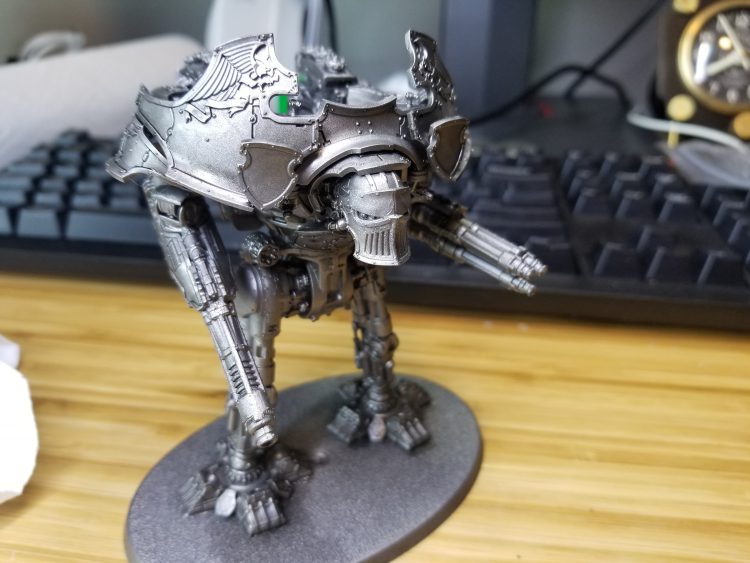
As you can see in this image, I’ve left the leg armor off the model for finishing at a later time, more on that later.
Step 2: Preshade
I used a combination of Citadel Nun Oil and Tamiya Black Panel Accent Highlighter to preshade the major areas of this model, to allow me to more clearly define and outline major structural areas of the model, and to guide my painting in later stages. It’s important to take your time with this step and really focus on the cut-ins present on the skeletal frame and some of the attached armor panels.

Step 3: Basecoating
This is the meat of the action for this model, and you’ll be spending the majority of your time fine-tuning the work you put here. Now, being an intelligent player, you’re putting down the red and white livery of the Legio, which means you’ll need to be careful about overpainting, and maintaining the crisp definition that makes painting these models so enjoyable. I used the following paints to achieve my first basecoat:
White: Celestra grey
- Red: Mephiston Red
- Trim: Baltasar Gold
Frame/Weapons: Leadbelcher (for touch ups)
By the end of this phase, your main model should look something like this:
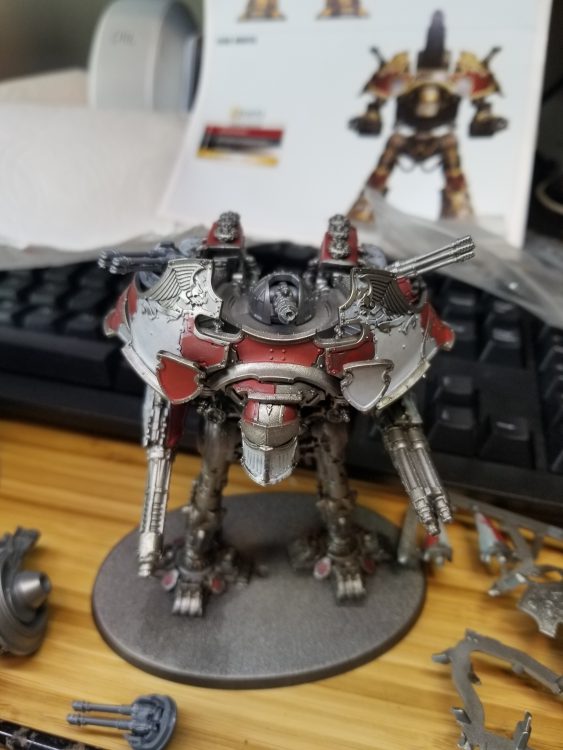
Additionally, you should be working on your armor panels at this time, I leave mine on the sprue for easier management, and clip/touch up when final assembly is needed. Here’s what mine looked like at this phase:
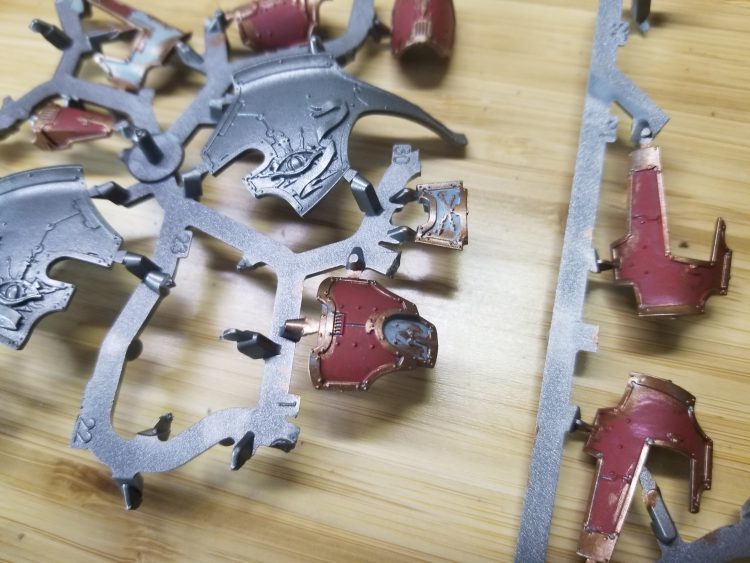
Step 4: Highlights and assembly
Here I take the model to the next level, I fill in all white areas with a thin coat of Citadel Contrast Apothecary White, and I cover the red sections with a 2:1:1 Mix of Mephiston Red Air, Wazdakka Red, and water, to achieve a more Omnissiah-pleasing red. Note that I’m still making quite a few mistakes here that will be covered up in the final phase.

Additionally, I’m starting to go over the gold trim with Citadel Warplock Bronze to start working towards an oily sheen on the final product. Here you will also put down your base paint. I’ve used Agrellan Earth from the Citadel Texture line for this model, and all my Fortidus models.
At the end of this phase, your chassis should look (again, something…) like this:

Step 5: Finishing Touches
In this step, I clean up any sloppy areas of overpainting, reusing my primary colors to touch up various areas, and generally brighten up elevated portions of the carapace.
I go over any bronze trim with Vallejo Game Air Bright Bronze Metallic to give a really nice pop to those areas.
Lenses: All my legio use Green or Blue lenses that I achieve with Citadel Gem Technical Paints. I’m very partial to the Waystone Green or Soulstone Blue. Be sure to undercoat with leadbelcher and a silver for best effect.
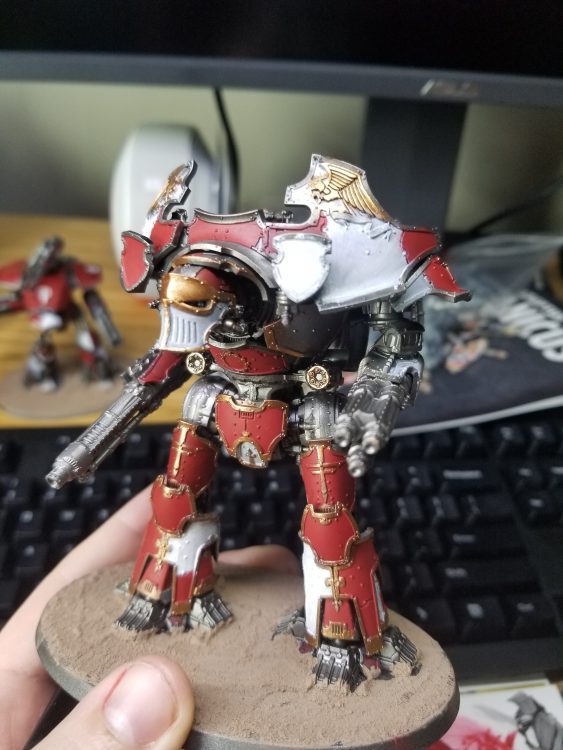
I also heavily dry-brush the weapons and back-mounted auto loader systems (those little boxes above the engine deck? Yeah, they’re magazines for the quake cannon- so cool), I also paint a bit of a bronze trim around the exhaust manifold to break up the back a little bit.
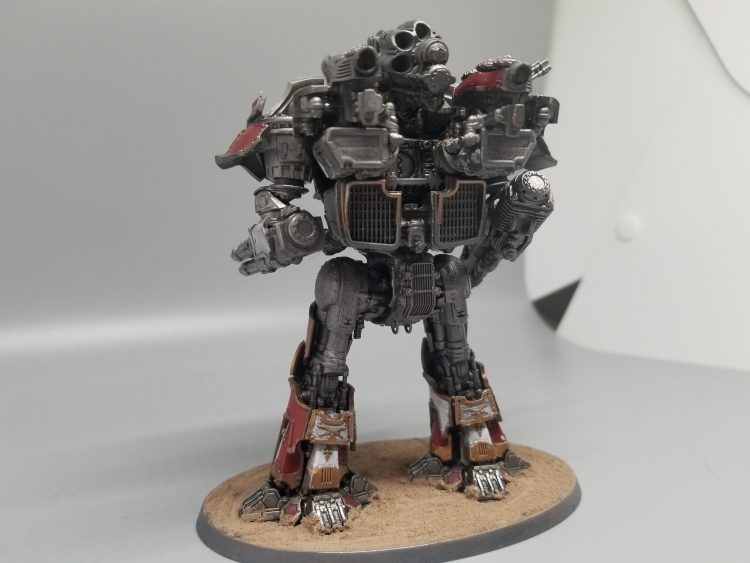
To finish, I aggressively dry brush the entire model with Vallejo Metallic Steel, to simulate general wear, and to show that the titan has been in the field for way too long.
I also take a mix of Citadel Nuln Oil Gloss wash, Citadel Lahmian Medium and local Tap Water, in a ratio of 2:2:4 and liberally apply it to the entire model, making sure to keep moving around any build up to avoid tide marks. This acts as a quick and dirty weathering, and to me at least, sells the fact that the legion is operating beyond its line of supply and support
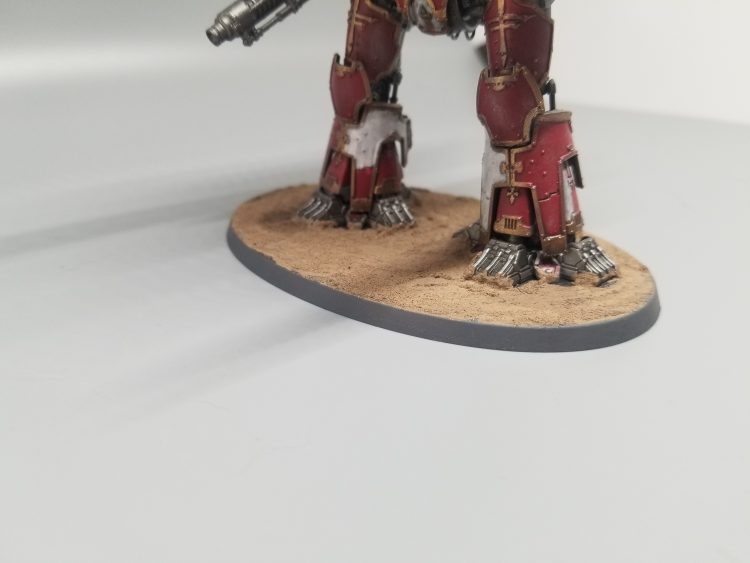
Continuing steps:
Please note that my pets have hidden the two turrets for this model, so my guide is somewhat incomplete. As there are no decals or transfers for Fortidus on offer at the moment, I will cut and scuff up markings from the generic titan transfer sheet on some of my models, or avoid using them at all.
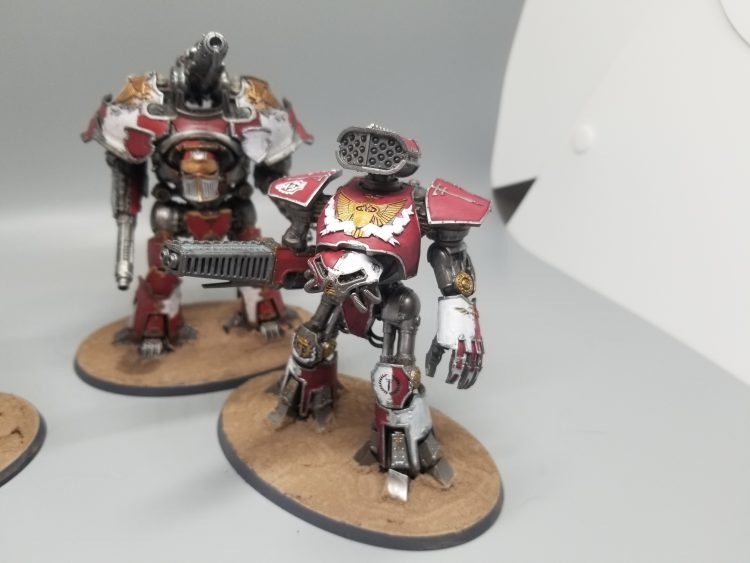
My take on Fortidus is that the survivors are under-resourced in both equipment and servants to keep more than their paint on their machines, and I plan on painting my battlestripes on these machines once they’ve actually fought a battle.
Fortidus in Adeptus Titanicus
Having suffered such major losses during the Schism of Mars, the orphaned forces refused to go down without a fight, making do with what they had on hand and holding the line at any cost against the tide of traitors. You can find the rules for them in the Doom of Molech supplement.
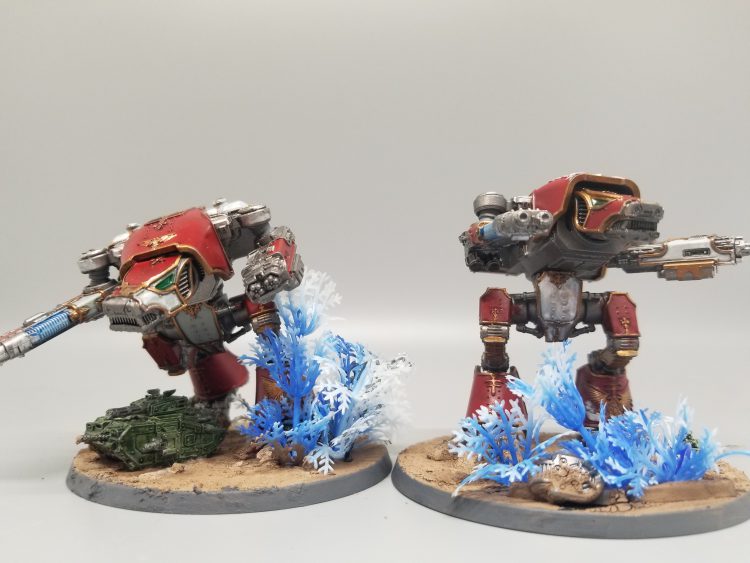
Tactical Overview
Legio Fortidus’s Lost Sons trait is the core of their rules, and will define how you’ll approach building your lists and playing games when you field the Dauntless. This trait reflects the heavy losses the Titan suffered and how they adapted and pushed forward in spite of those setbacks, granting them the interesting and powerful ability to swap out a mandatory Titan with a Warlord, Reaver or Warhound Titan.
Bair: However, maybe a little frustrating as we receive new releases of more Titans that any additions will not fit into older maniples: shoving a Warbringer into a Myrmidon could have been great fun, but that’s not an option.
One important thing to note here is that this ability has been errated as of February 2020 to no longer make the replacement Titan count as the same class as the one it replaced. Previously this allowed for some rather comical combinations, such as a Warlord in a Lupercal squadroning with Warhounds.
Soggy: Boo! I’m still upset.
Bair: I played against this, and it was funny, but oh my God-Emperor it was brutal and made for a tough fight. Can’t say I’m mad about the change.
Even with this change in mind, it still opens up a huge breadth of options with list creation such as being able to to take a smaller chassis instead of a larger one to allow for multiple maniples, or simply using a maniple whose benefit isn’t key-worded to a particular chassis. We’ll explore this further in the Maniple Choice section.
Children of Mars makes Dauntless Titans never suffer penalties to their Command checks and ignore any abilities that force them to reroll successful ones. This won’t often be relevant, but is a nice thing to have in case your opponent wants to use something like Wails of the Damned. The stoic nature of their Princeps also means that any Knight Banners that are in line of sight are entitled to re-roll command checks to avoid becoming Shaken. This half of the trait a great ability to ensure that your Knights stay in the fight even if they take losses, potentially pulling off that vital charge order and netting you a crucial engine kill when it counts.
For the Red Planet is expensive at 2CP. It’s a potentially useful effect, but you’ve got better investments for these points.
Red Skies allows you to add 5 to a Titan’s scale when suffering a magazine detonation or catastrophic meltdown for a single stratagem point. Given this relies on you losing a Titan in close proximity to your opponents and rolling well on the Catastrophic Meltdown table it is unlikely to trigger. You could force this with Even in Death for a bit of a gimmick which results in a memorable chain reaction, but we wouldn’t recommend spending 3 stratagem points on this.
Legio Dauntless has one stand out personal trait, Soldier of the Crusade. This gives your battlegroup an additional stratagem point before the start of the game. Given the huge number of stratagems on offer, this gives you loads of flexibility depending on what you face on the day. This is a solid choice for your second Princeps Seniores, especially if you’re bringing more than one maniple – something you’ll be able to do more frequently by taking advantage of Lost Sons to manage the points cost of your battlegroup.
Maniple Choice
Lost Sons lets you break the normal rules of maniple construction, granting you loads of unique options. While certainly not as strong as it once was, there are still plenty of maniples where the substitute still receives the benefit of the trait:
- Axiom – the classic choice, use this to substitute in your favoured chassis in place of another.
- Myrmidon – Not seeing the table often, you could substitute a mandatory Warlord with a smaller chassis to bring the overall cost down. It’s not often you would first fire or splitfire on a Warhound, but being able to do it on a 2+ is an option we suppose.
- Venator – sub a Reaver in for one of the Warhounds, and you can choose between the two Titans when taking your free shot from the maniple trait. This lets you steal one of Gryphonicus’s signature tricks, and it works about as well for you as it does for them.
- Corsair – The ability to move outside arc at normal movement applies to all titans in the battlegroup. This could be rather useful on a flanking Warhound or a brawler Warlord – being able to move 4” sideways or backwards to ensure targets stay within firing corridors is very useful.
- Fortis – Titanic Fortress applies to all titans in the maniple, allowing you to share shields and ignore flanking or structural damage bonuses when standing still. Consider dropping a Warlord for a Reaver to bring the cost down.
- Ferrox – The Ferrox trait applies to all titans in the maniple, allowing them to excel at targets within scale distance and close combat. While this could allow you to substitute into a Warlord, Knife Fighters requires you to close within scale which will often deny you use of your carapace weapons. Subbing in another Reaver or Warhound allows you to play to your preference of the two chassis, both of which have no problems getting in close and will still keep their accuracy due to Knife Fighters.
Condit Note: Subbing in a Brawler Warlord would still be nasty, though – a macro-gatling blaster and Sunfury on maximal both getting called shots on 4+ from within 2” is going to cause serious damage, even if you aren’t able to bring the carapace weapon to bear. However, you will need to close to use the trait, which can be difficult. - Dominus – Both traits apply regardless of the Titan chassis. You can drop the Warlord for a smaller chassis to open space for more Knights, who will also benefit from Children of Mars. Definitely worth considering if you want to run Knights in Dauntless.
- Janissary – We suppose the Children of Mars thing helps the knights? Skip this.
- Ruptura – Due to the FAQ you could opt to substitute one of the mandatory Warbringers for another Reaver, allowing for more reavers to close the gap when your Warbringer finishes off a Titan, although this becomes harder with only one on the table.
- Mandatum – The trait is hard-coded to Warhounds and Warlords, but you could substitute in an additional Warlord, granting more chances to trigger the Pack Master trait. It’s a little weird, but if you’re looking for a more aggressive trait for your Regia list, you could try this out.
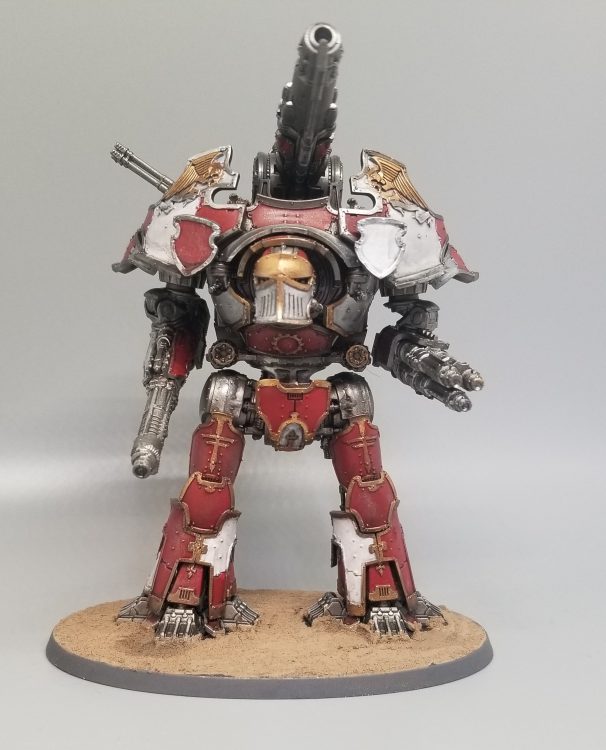
With all that in mind, let’s take a look at an example 1500 point list which takes advantage of the shenanigans Legio Dauntless offers. This list is a solid starting point for a beginning player, but also has plenty of options for a veteran to play around with:
Legio Dauntless Battlegroup – 1500 pts
Corsair Light Maniple – 840 pts
Reaver Titan – 310 pts
- Princeps Senioris – Dominant Strategist
- Melta Cannon
- Gatling Blaster
- Vulcan Megabolter
Reaver Titan – 310 pts
- Laser Blaster
- Gatling Blaster
- Turbo-Laser Destructor
Warhound Titan – 220pts
- Plasma Blastgun
- Vulcan Megabolter
Lupercal Light Maniple – 660 pts
Warhound Titan – 220pts
- Princeps Senioris – Soldier of the Crusade
- Plasma Blastgun
- Vulcan Megabolter
Warhound Titan – 220pts
- Plasma Blastgun
- Vulcan Megabolter
Warhound Titan – 220pts
- Plasma Blastgun
- Vulcan Megabolter
Bang on 1500 points, this battlegroup has loads of board control along with flexible activations. Astute readers will notice that, while this roster has the same assortment of Titans as last week’s Tempestus double Ferrox battlegroup, each force will play very differently with the options available to them. It says alot for the system that two forces with identical models can be built in such different ways, particularly with a force made from the new starter and a single box of warhounds.
We also mentioned last week that the pairing of a Corsair and Lupercal is a force to be reckoned with, but it usually doesn’t fit in at 1500 points. We’ve used the Lost Sons trait to substitute a Warhound into the Corsair Maniple, bringing its overall cost down just enough to make everything fit. The two moonwalking Reavers will be vital to causing structural damage, getting into the flanks of targets that have lost their voids to the pack of Warhounds. While it’s already the most nimble class of titan, the standalone Warhound will be even more frustrating for your opponent to keep track of thanks to the Fighting Withdrawal trait.
The Lupercal Maniple is always a great pick with its unbridled aggression and phenomenally low point cost. The ability to change squadrons on the fly is one of the best maniple traits in the game, allowing you to run three solo Warhounds on the first turn for a total of 6 activations, then combine them into a single squadron later on to alpha strike your unfortunate opponent.
Soldier of the Crusade gives you an additional stratagem point, which isn’t as good as it used to be as everyone has more with the new FAQ. That said, 6 stratagem points in most games is a huge toolbox to work with and will allow you to ensure you can cater to the game on the day.
The Dominant Strategist trait will let you steal the Opus at the start of the phase of your choice, letting you set up for maximum damage with your Lupercal maniple. Note that we’ve put this on a Reaver as it has less chance of being focused down before you get to use the ability.
If you wanted to change things up, we’d start by swapping a pair of the Warhounds in the Lupercal for dual turbo-lasers: they’re the same points cost as the plasma/bolter loadout and can call shots to finish off wounded targets. You could also swap the third one in the Lupercal if you wanted, but we recommend leaving the solo Warhound in the Corsair in the plasma/bolter loadout – the blastgun’s Maximal Fire trait will let it do good damage to armor without having access to Coordinated Strikes. For a little more long-range fire, you could swap the laser blaster on one of the Reavers for a volcano cannon. If you do, you could also consider swapping the carapace turbo-lasers for an apocalypse missile launcher so you have two weapons that can fire at longer ranges. Be sure to mount your long range weapons on the same Titan to ensure as many weapons are in range as possible.
Playing against Dauntless
Take a careful look at a Dauntless opponent’s list before your game with them – chances are they’re going to be using Lost Sons to bring a list that functions slightly different from other legions using the same maniple. Examples to keep an eye out for are the double-Reaver Venator gimmick, or a moonwalking Warlord in a Corsair. Think about how your opponent’s Lost Sons replacement will affect how they’ll play their list.
Remember their Children of Mars trait will allow them to ignore leadership penalties from Wails of the Damned or similar effects. This will also allow their Knights to re-roll to avoid being shaken, so you may need to give a Cerastus Knight Banner more attention to ensure they can’t charge. Don’t waste your CP or personal trait on effects that modify Command checks when you’re facing Dauntless, and don’t count any Knight banners out until they’re actually dead.
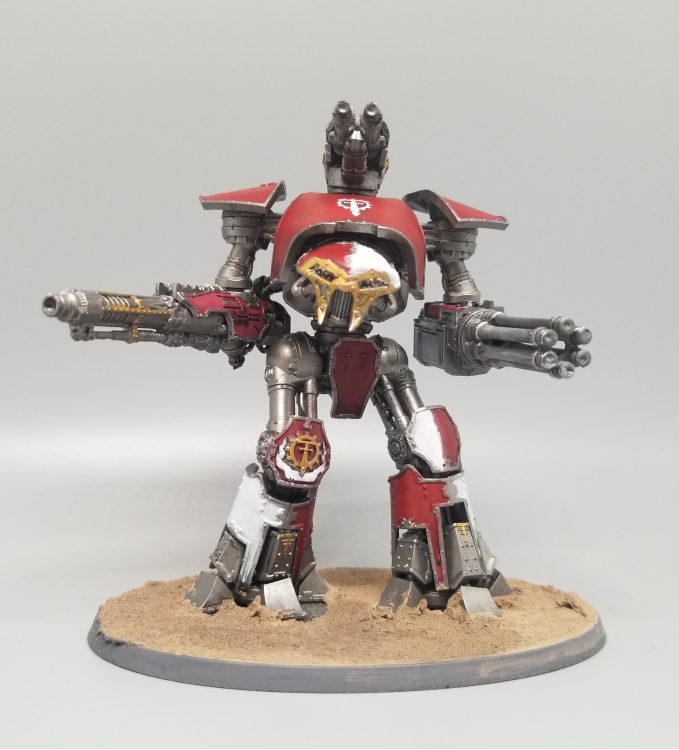
For the Glory of Holy Mars
Even after taking a significant hit to their signature trait, Legio Fortidus still ranks amongst the most flexible of all the Titan legions. The Dauntless are no strangers to fighting back against terrible odds, and they’ve still got plenty of tricks up their sleeves in spite of the recent changes. With your ability to change the mandatory elements of your maniple, you’ve got a lot of list-building space to play with and can throw your enemies some serious curve-balls. Muster your battlegroup and show your opponents what it means to never say die.
